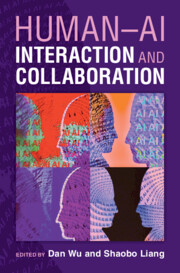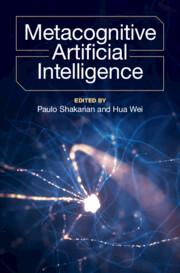Refine search
Actions for selected content:
3312 results in Artificial Intelligence and Natural Language Processing
Part I - Introduction
-
- Book:
- Metacognitive Artificial Intelligence
- Published online:
- 08 September 2025
- Print publication:
- 25 September 2025, pp 1-2
-
- Chapter
- Export citation
Part IV - Metacognition with LLMS
-
- Book:
- Metacognitive Artificial Intelligence
- Published online:
- 08 September 2025
- Print publication:
- 25 September 2025, pp 109-110
-
- Chapter
- Export citation
10 - The Role of Predictive Uncertainty and Diversity in Embodied AI and Robot Learning
- from Part V - Metacognition in Learning Agents
-
-
- Book:
- Metacognitive Artificial Intelligence
- Published online:
- 08 September 2025
- Print publication:
- 25 September 2025, pp 148-182
-
- Chapter
- Export citation
3 - Metacognitive AI through Error Detection and Correction Rules
- from Part II - Taxonomy of Metacognitive Approaches
-
-
- Book:
- Metacognitive Artificial Intelligence
- Published online:
- 08 September 2025
- Print publication:
- 25 September 2025, pp 44-55
-
- Chapter
- Export citation
4 - Mutual Trust in Human–AI Teams Relies on Metacognition
- from Part II - Taxonomy of Metacognitive Approaches
-
-
- Book:
- Metacognitive Artificial Intelligence
- Published online:
- 08 September 2025
- Print publication:
- 25 September 2025, pp 56-80
-
- Chapter
- Export citation
Part V - Metacognition in Learning Agents
-
- Book:
- Metacognitive Artificial Intelligence
- Published online:
- 08 September 2025
- Print publication:
- 25 September 2025, pp 133-134
-
- Chapter
- Export citation
Contributors
-
- Book:
- Metacognitive Artificial Intelligence
- Published online:
- 08 September 2025
- Print publication:
- 25 September 2025, pp viii-x
-
- Chapter
- Export citation
7 - Metacognitive Intervention for Accountable LLMs through Sparsity
- from Part IV - Metacognition with LLMS
-
-
- Book:
- Metacognitive Artificial Intelligence
- Published online:
- 08 September 2025
- Print publication:
- 25 September 2025, pp 111-120
-
- Chapter
- Export citation
Part III - Neuro-Symbolic Models in AI
-
- Book:
- Metacognitive Artificial Intelligence
- Published online:
- 08 September 2025
- Print publication:
- 25 September 2025, pp 81-82
-
- Chapter
- Export citation
Part VIII - Applications of Metacognitive AI
-
- Book:
- Metacognitive Artificial Intelligence
- Published online:
- 08 September 2025
- Print publication:
- 25 September 2025, pp 257-258
-
- Chapter
- Export citation
1 - Metacognitive AI
- from Part I - Introduction
-
-
- Book:
- Metacognitive Artificial Intelligence
- Published online:
- 08 September 2025
- Print publication:
- 25 September 2025, pp 3-22
-
- Chapter
- Export citation

Human-AI Interaction and Collaboration
-
- Published online:
- 19 September 2025
- Print publication:
- 09 October 2025

Metacognitive Artificial Intelligence
-
- Published online:
- 08 September 2025
- Print publication:
- 25 September 2025
Copyright page
-
- Book:
- Lost in Automatic Translation
- Published online:
- 08 October 2025
- Print publication:
- 21 August 2025, pp iv-iv
-
- Chapter
- Export citation
Chapter 2 - Call the Grammar Police
- from Part I - Communicating in English
-
- Book:
- Lost in Automatic Translation
- Published online:
- 08 October 2025
- Print publication:
- 21 August 2025, pp 22-36
-
- Chapter
- Export citation
Chapter 6 - Grounded in Reality
- from Part II - Understanding Cultural Norms and References
-
- Book:
- Lost in Automatic Translation
- Published online:
- 08 October 2025
- Print publication:
- 21 August 2025, pp 94-114
-
- Chapter
- Export citation
References
-
- Book:
- Lost in Automatic Translation
- Published online:
- 08 October 2025
- Print publication:
- 21 August 2025, pp 177-189
-
- Chapter
- Export citation
Part II - Understanding Cultural Norms and References
-
- Book:
- Lost in Automatic Translation
- Published online:
- 08 October 2025
- Print publication:
- 21 August 2025, pp 37-136
-
- Chapter
- Export citation
Part III - Cultural Integration through Language
-
- Book:
- Lost in Automatic Translation
- Published online:
- 08 October 2025
- Print publication:
- 21 August 2025, pp 137-171
-
- Chapter
- Export citation
Chapter 4 - A Figure of Speech
- from Part II - Understanding Cultural Norms and References
-
- Book:
- Lost in Automatic Translation
- Published online:
- 08 October 2025
- Print publication:
- 21 August 2025, pp 51-68
-
- Chapter
- Export citation
